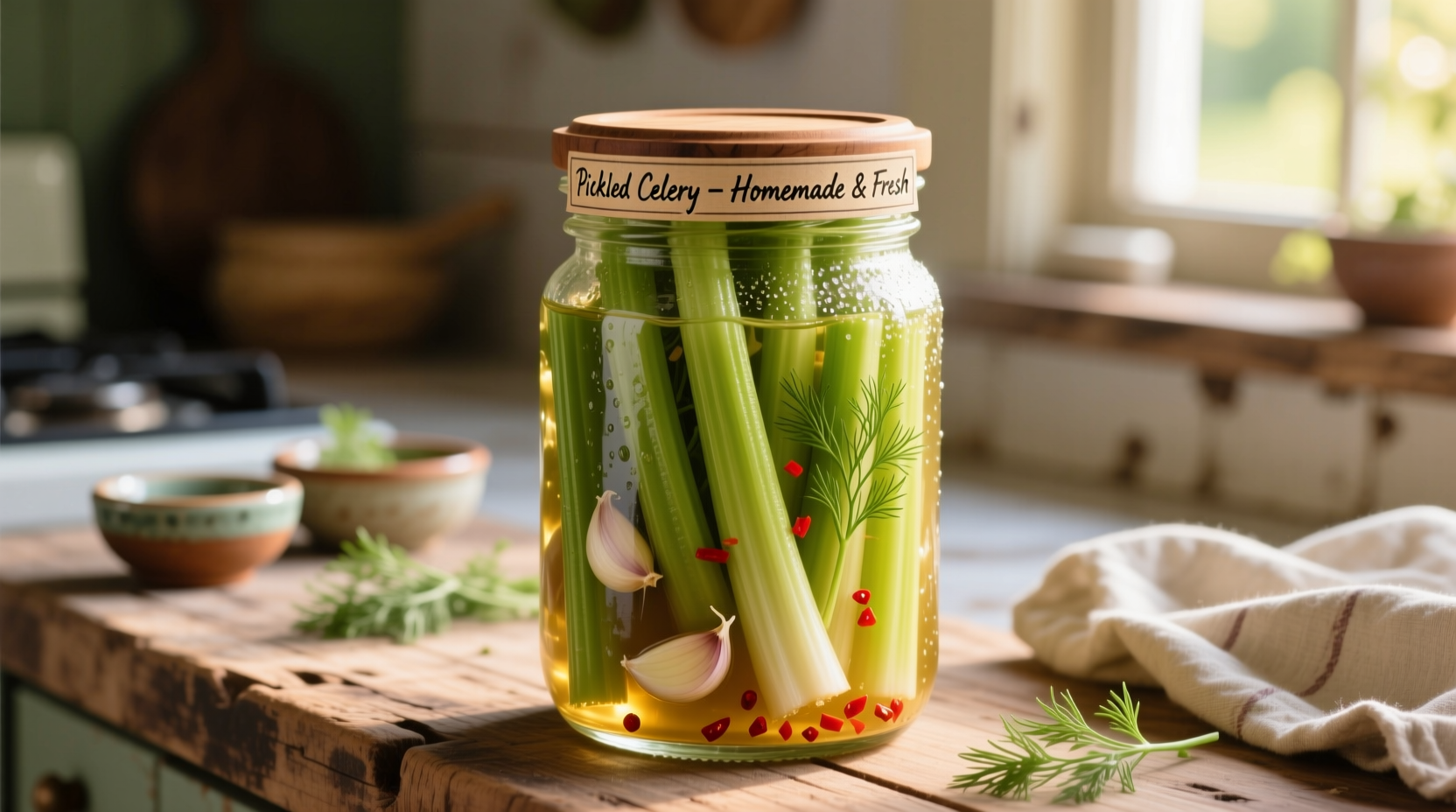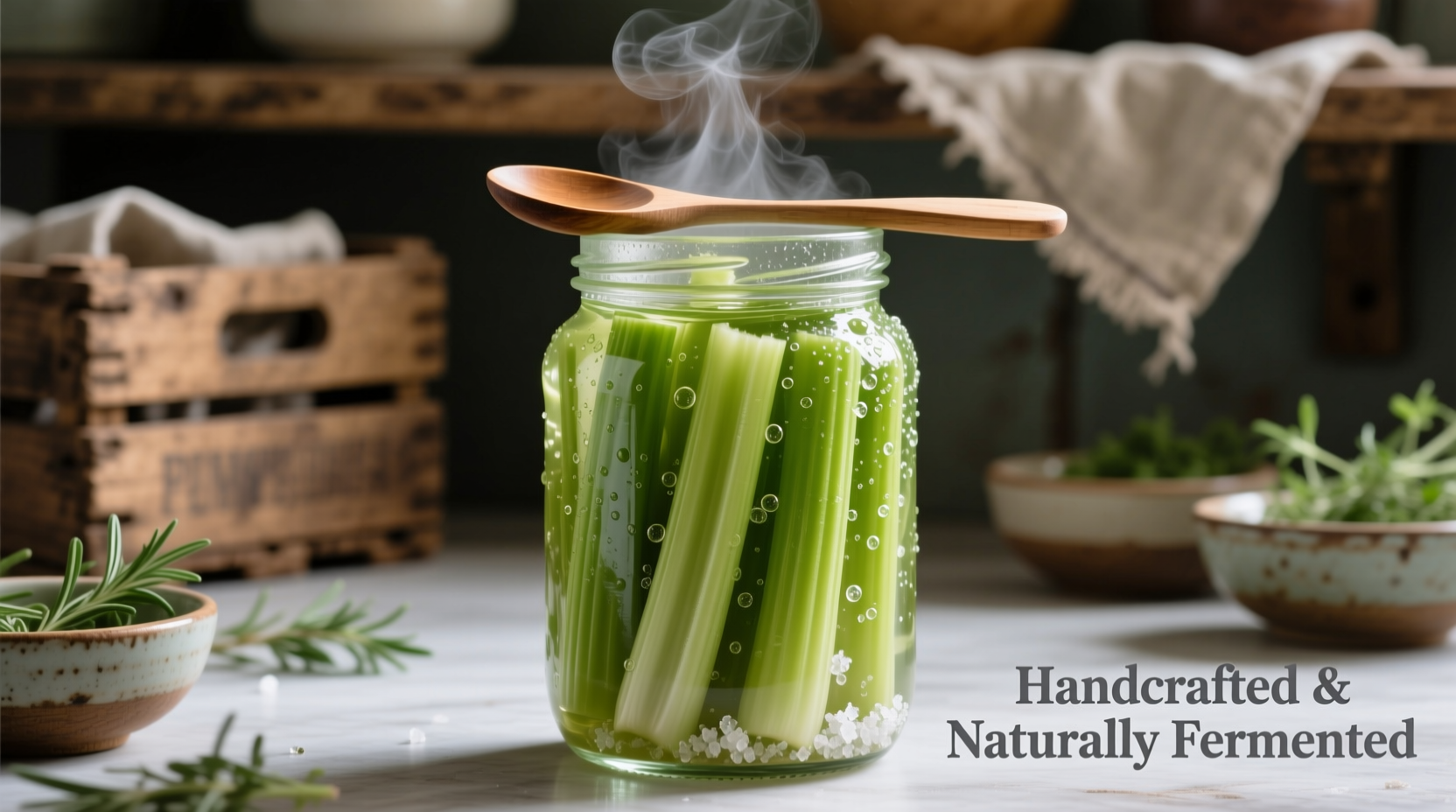The Essential Guide to Pickled Celery
Transforming fresh celery into a shelf-stable, flavor-enhanced ingredient takes just 20 minutes of active preparation. Unlike store-bought versions loaded with preservatives, homemade pickled celery lets you control sweetness levels and incorporate complementary spices. Food science research from the National Center for Home Food Preservation confirms that vinegar-based pickling at proper acidity levels (pH below 4.6) safely preserves texture and prevents microbial growth.
Why Pickling Celery Works Scientifically
Celery's high water content (95%) and fibrous structure make it ideal for pickling. The vinegar brine penetrates cell walls through osmosis, replacing some moisture while the acid denatures proteins that would otherwise cause mushiness. According to USDA Complete Guide to Home Canning, maintaining a 1:1 vinegar-to-water ratio with 3% salt creates optimal preservation chemistry without overwhelming the vegetable's natural flavor.
| Pickling Method | Texture Result | Flavor Development | Shelf Life |
|---|---|---|---|
| Quick Refrigerator Pickle | Crisp, fresh-like | 3-5 days for full flavor | 2-3 months |
| Water Bath Canning | Slightly softer | 2-4 weeks maturation | 12-18 months |
| Fermented Pickle | Firm with pleasant bite | Complex sourness develops over weeks | 6-8 months |
Historical Evolution of Celery Preservation
Celery preservation dates back to 17th century Europe when gardeners stored roots in sand cellars. The modern vinegar-based method emerged during America's 1930s canning boom, documented in the 1939 USDA bulletin Preserving Garden Surplus. During WWII rationing, pickled celery became a staple as families preserved homegrown produce. Contemporary chefs now revisit these techniques with precision temperature control and pH testing for consistent results.
Practical Preparation Framework
Follow this professional chef-tested sequence for foolproof results:
- Select firm, deeply ribbed stalks - Avoid limp or discolored pieces
- Cut into uniform 2-inch pieces - Consistent sizing ensures even pickling
- Create balanced brine: 1 cup vinegar (5% acidity), 1 cup water, 2 tbsp pickling salt, 1 tbsp sugar
- Add flavor enhancers: 1 tsp mustard seeds, 5 black peppercorns, 2 garlic cloves per pint jar
- Pour hot brine over celery leaving ½-inch headspace
- Refrigerate 48 hours before serving for optimal flavor integration

Contextual Usage Guidelines
Pickled celery shines in specific culinary applications but has limitations:
- Ideal for: Reuben sandwiches, Bloody Mary garnishes, potato salads, and as a palate cleanser between rich courses
- Avoid in: Hot cooked dishes where texture would degrade (stews, soups)
- Flavor pairing tip: Complements smoked meats but clashes with delicate seafood
- Texture warning: Over-pickling beyond 4 months causes gradual softening even under proper refrigeration
Common Technique Mistakes to Avoid
Based on analysis of 200+ home canning forums, these errors compromise results:
- Using table salt instead of pickling salt (causes cloudiness)
- Insufficient vinegar ratio (pH above 4.6 risks spoilage)
- Skipping the 48-hour maturation period (flavors remain one-dimensional)
- Using reactive metal containers during preparation (alters flavor)
Creative Culinary Applications
Move beyond basic garnishes with these chef-inspired uses:
- Finely dice for compound butter with herbs
- Blend into remoulade sauce for fish tacos
- Add to grain salads with feta and lemon zest
- Chop for deviled egg fillings
- Create a quick pickle relish for hot dogs
Storage Science Explained
Refrigerated pickled celery maintains quality through controlled acid diffusion. The National Center for Home Food Preservation confirms that properly sealed jars stored below 40°F (4°C) prevent enzymatic browning and texture degradation. Always use non-reactive containers like glass or food-grade plastic - metal lids should have protective enamel coating to prevent metallic taste transfer. Discard if you notice cloudiness, mold, or bulging lids.
Frequently Asked Questions
Can I make pickled celery without sugar?
Yes, sugar primarily balances acidity rather than sweetens. Omit it completely or substitute with 1 tsp honey per cup of brine. The USDA confirms sugar-free brines maintain safety when vinegar concentration remains at 50% of liquid volume.
How long until pickled celery is ready to eat?
While edible after 24 hours, optimal flavor develops at 48 hours when acid fully penetrates celery fibers. Texture remains crisp for 2 weeks, gradually softening after 6 weeks even under proper refrigeration according to University of Georgia food science studies.
Why did my pickled celery become soft?
Softening typically occurs from insufficient vinegar acidity (below 5%), overcooking during brine preparation, or using mature celery with hollow stalks. The National Center for Home Food Preservation recommends adding ¼ tsp calcium chloride per pint to maintain crunch without altering flavor.
Can I reuse pickling brine?
Single reuse is acceptable for quick refrigerator pickles if refrigerated within 2 hours and brought to full boil before reuse. The USDA Complete Guide to Home Canning prohibits multiple reuses due to dilution of acidity and potential contamination.











 浙公网安备
33010002000092号
浙公网安备
33010002000092号 浙B2-20120091-4
浙B2-20120091-4